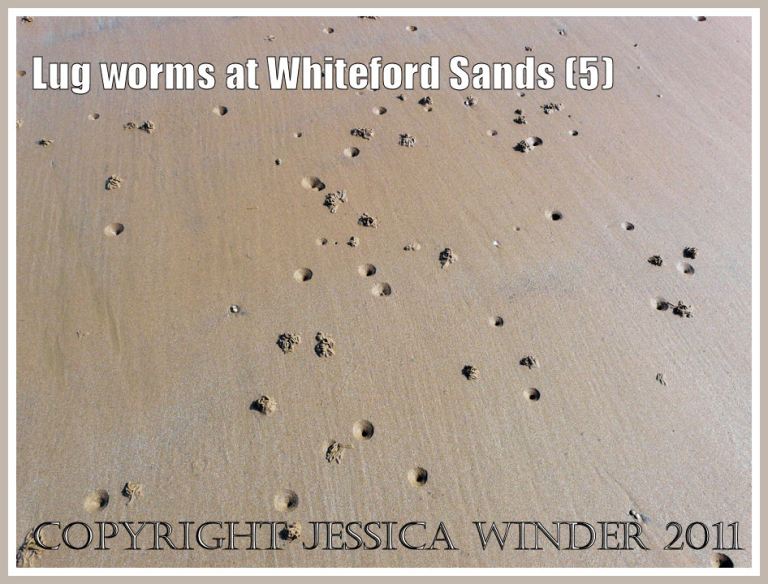Lug-worm casts extending like a vast field of walnut whips as far as the eye can see at Whiteford Point, Gower in South Wales. These casts are made by the marine worm Arenicola marina Linnaeus.
Blow hole and spiral cast of the Blow Lug or Lug Worm – each representing opposite ends of the U-shaped tube occupied by the worm in the sand.
Blow hole of the Lug Worm in sediments of Whiteford Sands in Gower. The head end of the worm lies beneath this hole and the worm eats the sand in order to get nutrients from the detritus and micro-organisms that it contains.
The tail end of the worm lies beneath the spiral worm cast that is composed of the excreted sediments after they have passed through the worm’s gut.
In the picture below you can see from the widely spaced distribution of blow holes and worm casts that Lug Worms on the beach at Whiteford Sands are not so abundant as at Whiteford Point (illustrated at the top of this post)because the sediments are drier, more sandy, less muddy, and therefore with a smaller organic component.
For more pictures showing the living Lug Worm itself, and video clips of Lug Worms click here for the ARKive web site.
Revision of a post first published 1 May 2009
COPYRIGHT JESSICA WINDER 2011
All Rights Reserved






Beautiful pictures – love that last one. Can hardly wait to get back to Whiteford again but it’ll probably be next year before I get the chance to. Excellent post.
LikeLike
Whiteford Sands.
wer abouts iz it ?
LikeLike
Whiteford Sands is on the Gower Peninsula in South Wales, UK, near to Swansea.
LikeLike
Great photos and information! I was recently wandering along the east coast of Scotland and found some piles of casts like the ones in your photos, but did not see any blow holes near them. Do you have any idea why that might be?
LikeLike
Thanks, Janet. I think that possibly if the substrate into which the worms were burrowing was very wet, fine or fluid, then the blow hole might close up easily and therefore only be apparent to the observer periodically. When the substrate is drier, then the hole remains open.
LikeLike
Thank you. Yes, the sand was quite wet and the sand was indeed fine, so you are probably right. Just wondered because the castings kept their shape so well.
LikeLike
That is the only thing I can think of to explain it. Maybe the castings drained off and became slightly drier in the air and that preserved their shape better.
LikeLike
Excellent thought. Thanks again!
LikeLike
Hi Jessica, found this blog post while hunting for photos worm casts after I found so many at Minehead on my coastal walk. Glad to see I’m not the only one fascinated by their hieroglyphic shapes.
LikeLike
They are a rather odd phenomenon aren’t they? I think the worms occur more frequently when the sand is full of good things for them to eat.
LikeLike